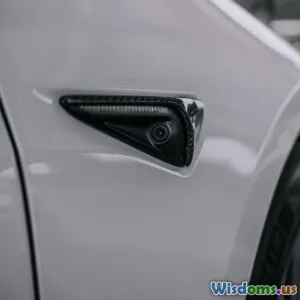
5 Unexpected Ways Advanced Safety Features Impact Daily Driving
7 min read Discover 5 surprising ways advanced safety features transform everyday driving beyond crash prevention. (0 Reviews)
5 Unexpected Ways Advanced Safety Features Impact Daily Driving
Modern automobiles have evolved far beyond simple transportation machines. The integration of advanced safety features—once viewed solely as tools to prevent accidents—has transformed the driving experience in unexpected ways. From helping drivers conserve fuel to reshaping insurance landscapes, these technologies redefine how we interact with our vehicles daily.
In this article, we dive into five surprising impacts that advanced safety features impart on daily driving.
1. Boosting Driver Confidence and Reducing Stress
Advanced safety systems such as Adaptive Cruise Control (ACC), Lane-Keeping Assist, and Traffic Jam Assist don't just function as protective measures; they also elevate driver confidence.
Real-World Insights:
According to a 2023 J.D. Power study, 68% of drivers who regularly use lane-keeping and collision avoidance technologies report feeling less stressed during long commutes. These features automate tedium-inducing tasks like maintaining safe following distances and lane discipline, which typically demand constant attention.
For example, ACC dynamically adjusts your speed to maintain a safe gap from the car ahead, easing the constant throttle, brake, and clutch modulation especially in heavy traffic. Traffic Jam Assist pairs ACC with steering inputs to assist in stop-and-go traffic scenarios, reducing driver fatigue.
These systems reduce the cognitive load on drivers, particularly in urban settings prone to congestion, making daily commutes feel safer and more relaxed.
2. Energy Efficiency Through Smarter Driving Assistance
Many advanced safety features also influence how efficiently you drive, often without you realizing it. Features like Predictive Cruise Control and Intelligent Speed Adaptation optimize acceleration and deceleration, contributing to lower fuel consumption.
Practical Example:
Mercedes-Benz’s Predictive Speed System, which uses GPS data and topographical information, adjusts vehicle speed based on road gradients and corners. Tests reveal that such systems can improve fuel economy by 5-10% on hilly drives.
By preventing unnecessary sharp braking and sudden acceleration, these technologies not only enhance safety but also reduce your environmental footprint and save money at the pump.
3. Parking Made Easier and Safer
Parking has traditionally been a challenging aspect of daily driving, especially in dense urban environments. Advanced safety features like 360-degree cameras, automatic parking assistance, and reverse parking sensors revolutionize this process.
Data and Application:
A study by AAA indicates that vehicles equipped with parking assistance features reduce parking-related dents and scratches by nearly 40%.
Tesla’s Autopark, for instance, can scan for suitable spots and autonomously maneuver the vehicle into place. This minimizes close calls with pedestrians and obstacles during parking—the moment when most low-speed incidents occur.
These innovations also save time and reduce frustration, especially for novice drivers or those parking in tight spaces.
4. Enhancing Navigation Through Safety-Integrated Smart Systems
Modern vehicles often combine safety and navigation, creating a seamless, intuitive driving experience. Advanced driver-assistance systems (ADAS) feed real-time data into navigation aids that modify route recommendations not just for distance and time but also safety.
Example:
Volvo’s Connected Safety technology shares hazard information between vehicles. If a driver ahead detects slippery roads or an accident, warnings get relayed to approaching cars, allowing navigation systems to adjust routes accordingly.
Moreover, Speed Limit Assist adjusts vehicle speed when entering zones with differing speed restrictions, helping drivers avoid inadvertent speeding infractions. This integration reinforces safer driving habits while guiding the driver efficiently.
5. Influencing Insurance Premiums and Ownership Costs
Advanced safety features indirectly influence your ownership costs by affecting insurance premiums. Insurers increasingly reward vehicles equipped with features such as Automatic Emergency Braking (AEB), Blind Spot Detection, and Forward Collision Warning with lower rates.
Industry Perspective:
The Insurance Institute for Highway Safety (IIHS) has documented that vehicles with AEB see a 15-20% reduction in crash claims. Consequently, many insurers offer discounts ranging from 5% to 15% for cars equipped with these technologies.
Beyond premiums, fewer accidents mean less time in repairs and reduced depreciation. Proactively adopting vehicles with safety tech can therefore offer financial benefits extending well beyond the sticker price.
Conclusion
Advanced safety features in today's vehicles transcend their initial purpose of collision prevention. They elevate daily driving by reducing stress, improving parking, enhancing navigation, promoting fuel efficiency, and lowering insurance costs. Understanding these unexpected benefits can inspire drivers to appreciate and utilize these technologies fully.
As automotive technology continues to evolve, embracing these innovative safety systems not only enhances personal driving experiences but also paves the way for safer, smarter roads tomorrow.
Take Action: Next time you evaluate a vehicle, consider the suite of advanced safety features it offers—not just for protection but for a better daily drive experience across the board.
References:
- J.D. Power 2023 Driver Confidence Report
- Mercedes-Benz Fuel Efficiency Studies
- AAA Vehicle Damage & Safety Survey 2022
- Volvo Connected Safety Program Documentation
- Insurance Institute for Highway Safety (IIHS) Crash Data
Rate the Post
User Reviews
Popular Posts





















